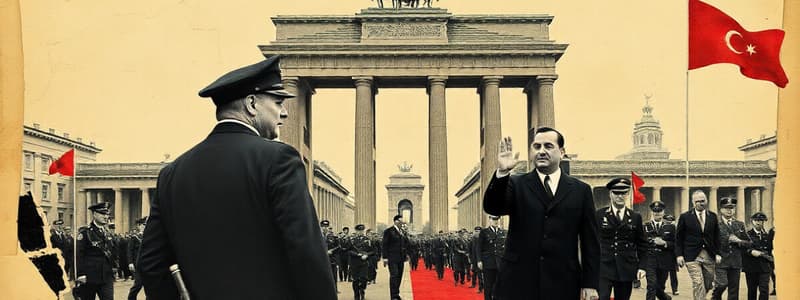Podcast
Questions and Answers
What was a primary disagreement between the Allied leaders at the Yalta and Potsdam Conferences?
What was a primary disagreement between the Allied leaders at the Yalta and Potsdam Conferences?
- The future of Germany and the political organization of Eastern Europe. (correct)
- The immediate withdrawal of all Allied forces from continental Europe.
- The administrative structure of the newly formed United Nations.
- The specific amount of financial reparations Germany would pay to each Allied nation.
What was the main goal of the Truman Doctrine?
What was the main goal of the Truman Doctrine?
- To promote cultural exchange programs between the USA and the USSR.
- To support nations resisting communism. (correct)
- To provide military support to rebuild infrastructure in war-torn Europe.
- To establish free trade agreements with Eastern European countries.
Why did Stalin prevent Eastern European countries from accepting Marshall Aid?
Why did Stalin prevent Eastern European countries from accepting Marshall Aid?
- He wanted those nations to focus on agricultural development rather than industrial reconstruction.
- He believed it would create economic dependency on the USA and undermine Soviet influence. (correct)
- He had already established similar aid programs through the COMECON.
- He feared it would lead to mass emigration from the Eastern Bloc to Western Europe.
Which event is considered the first major crisis of the Cold War?
Which event is considered the first major crisis of the Cold War?
What was the primary method used by the Western Allies to overcome the Berlin Blockade?
What was the primary method used by the Western Allies to overcome the Berlin Blockade?
What was the significance of the formation of West and East Germany in 1949?
What was the significance of the formation of West and East Germany in 1949?
What was the primary purpose of establishing NATO in 1949?
What was the primary purpose of establishing NATO in 1949?
How did the formation of the Warsaw Pact in 1955 impact the geopolitical landscape of Europe?
How did the formation of the Warsaw Pact in 1955 impact the geopolitical landscape of Europe?
By 1955, what was the overall state of Europe regarding the Cold War?
By 1955, what was the overall state of Europe regarding the Cold War?
Which of the following best describes Stalin's primary motivation in establishing communist governments in Eastern Europe?
Which of the following best describes Stalin's primary motivation in establishing communist governments in Eastern Europe?
How did ideological differences contribute to the rise of the Cold War?
How did ideological differences contribute to the rise of the Cold War?
What long-term effect did the Berlin Airlift have on the perception of the USA in West Germany?
What long-term effect did the Berlin Airlift have on the perception of the USA in West Germany?
In what way did the Marshall Plan contribute to the economic division of Europe?
In what way did the Marshall Plan contribute to the economic division of Europe?
Which of the following describes the effect of the arms race between NATO and the Warsaw Pact on the Cold War in Europe?
Which of the following describes the effect of the arms race between NATO and the Warsaw Pact on the Cold War in Europe?
What was a significant political consequence of the Berlin Blockade?
What was a significant political consequence of the Berlin Blockade?
Why can the period between 1945 and 1955 be considered crucial in the development of the Cold War?
Why can the period between 1945 and 1955 be considered crucial in the development of the Cold War?
Which of the following demonstrates how the Cold War affected internal politics within European nations?
Which of the following demonstrates how the Cold War affected internal politics within European nations?
How did the differing post-war visions for Germany contribute to the rise of the Cold War?
How did the differing post-war visions for Germany contribute to the rise of the Cold War?
What was the long-term impact of the formation of NATO and the Warsaw Pact on European security?
What was the long-term impact of the formation of NATO and the Warsaw Pact on European security?
In what way did the Truman Doctrine and the Marshall Plan represent a shift in US foreign policy?
In what way did the Truman Doctrine and the Marshall Plan represent a shift in US foreign policy?
Flashcards
The Cold War
The Cold War
Post-WWII tension between the USA and USSR due to differing ideologies, mutual distrust, and disagreements over Europe's future.
Yalta and Potsdam Conferences
Yalta and Potsdam Conferences
Meetings where Allied leaders disagreed on Germany's future and Eastern Europe's political structure.
Buffer Zone
Buffer Zone
A zone of communist states Stalin desired to protect the USSR from future invasions.
Eastern Bloc
Eastern Bloc
Signup and view all the flashcards
Truman Doctrine
Truman Doctrine
Signup and view all the flashcards
Marshall Plan
Marshall Plan
Signup and view all the flashcards
Berlin Blockade
Berlin Blockade
Signup and view all the flashcards
Berlin Airlift
Berlin Airlift
Signup and view all the flashcards
Creation of East and West Germany
Creation of East and West Germany
Signup and view all the flashcards
NATO
NATO
Signup and view all the flashcards
Warsaw Pact
Warsaw Pact
Signup and view all the flashcards
Study Notes
- The Cold War in Europe emerged soon after World War II in 1945.
- Tensions arose between the USA and the USSR due to ideological differences, mutual suspicion, and disagreements.
- The disagreements were centered around the future of Europe.
Origins (1945–1947)
- At the Yalta and Potsdam Conferences, Allied leaders disagreed over Germany’s future and the political setup of Eastern Europe.
- Stalin aimed to create a buffer zone of communist states to protect the USSR.
- The USA and Britain desired democratic governments in those areas.
- By 1947, the USSR had established communist governments across Eastern Europe, forming the Eastern Bloc.
- The USA introduced the Truman Doctrine to support countries resisting communism.
- The USA launched the Marshall Plan, offering economic aid to rebuild Europe.
- Stalin viewed these actions as threats and banned Eastern European countries from accepting Marshall Aid.
Development (1948–1955)
- The Berlin Blockade (1948–49) was the first major Cold War crisis.
- Stalin blocked all access to West Berlin in an attempt to force the Allies out.
- The Western Allies responded with the Berlin Airlift, supplying the city by air for almost a year.
- Stalin eventually lifted the blockade.
- In 1949, West Germany and East Germany were officially created, confirming the division of Germany.
- The formation of NATO (1949) by the West and the Warsaw Pact (1955) by the Eastern Bloc solidified the divide in Europe.
- These alliances increased military tension and the threat of conflict.
- By 1955, Europe was firmly split into two opposing camps.
- The Cold War had become a long-term political and military rivalry between the USA and USSR.
- Europe became the main battleground.
Studying That Suits You
Use AI to generate personalized quizzes and flashcards to suit your learning preferences.




